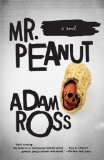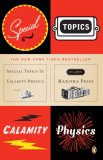Summary | Excerpt | Reading Guide | Reviews | Beyond the book | Read-Alikes | Genres & Themes | Author Bio

Critics' Opinion:
Readers' Opinion:
First Published:
Jun 2010, 352 pages
Paperback:
Apr 2011, 352 pages
 Book Reviewed by:
Book Reviewed by:
Elena Spagnolie
Buy This Book
The beginning of Adam Ross's first novel, Mr. Peanut, is extraordinarily alluring. He introduces the reader to David Pepin, a man who immediately falls in love with his future wife, Alice, in a college class on Alfred Hitchcock; but over the course of their thirteen-year marriage, David develops the morbid habit of fantasizing about her demise. The reader peers voyeuristically into his thoughts and sees what David never dares to speak out loud: Alice falling on the train tracks, Alice conveniently being struck by lightning, Alice crumpling under a fallen crane…
The elements of suspense are well set up and the hostile yet sexual nature of their relationship contributes to a sense of the bizarre. Alice's painful obesity is David's delight: "She was not his wife but a giant she-creature, an overlarge sex pet: his to screw, groom, and maintain". Tension builds, mean-spirited fights are subdued into sexual acts on a whim, and Ross raises questions about the relationship between love and anger. Are they intrinsically related? What silent and unseen process takes place in a marriage that creates so much hostility? And then Alice does die, found with traces of peanut meat--a food she is highly allergic to--in her mouth, and David is the main suspect.
Ross then introduces the characters of Detective Hastroll and Detective Sheppard, the two men sent to investigate Alice's murder, and begins a major and rather unexpected shift in the focus of the novel. Structured in segments that flash back and forth in time, Ross explores the equally miserable and non-communicative relationships between the detectives and their wives. The plotline of David and Alice all but vanishes for a good portion of the book, which in and of itself isn't a problem; it has the potential to serve as a MacGuffin, which Ross informs us "is what gets the story rolling but then fades in importance after it's introduced". However, in order for this device to be effective, a stronger idea should take the original plotline's place and lead the reader away from what was once so important, which does not seem to happen in Mr. Peanut. Instead, his characters slide into stereotypical gender roles (both the women and the men) that don't serve a larger purpose, and the relationships between all three couples devolve into overly dramatic, reactionary roles. While funny at first, the lack of communication between characters becomes frustrating to the reader, and few of his characters are ever asked to take responsibility for their actions. Ross incorporates the real-life story of Sam Sheppard who in 1954 was convicted of murdering his pregnant wife Marilyn and was later acquitted but, again, the limited character development prevents him from fully tapping the wealth (and the thrill) of that resource.
However, Ross successfully encourages readers to find parallels in the three couples' situations by weaving similar details throughout each story line. His use of description, particularly his sense of place (whether in New York, Hawaii or Ohio) transports readers and allows the setting to contribute to the telling of the story. And his attention to descriptive detail creates vivid images that stay with the reader. The end of Mr. Peanut starts to pick up, and the information given about Alfred Hitchcock explains some of the structural choices that the author makes, though it feels like the reader is waiting alongside him to figure out the ending. However, once he gets there, it is quite stirring, and motivates readers to start the book all over again.
Though I don't think that Mr. Peanut is a thorough examination of the nature of marriage or relationships, I do believe that Ross is attempting something deeper with this novel. The underlying themes are engaging (if not a little controversial), and his work invites discussion. I waiver between recommending this book and not, but I think that if you take the time to consider it, especially if you have the commitment to read it a second time, there are many interesting conversations to be had.
MacGuffin
A MacGuffin is essentially a filmatic diversion, popular in thrillers, which tends to be the central focus of the film in the first act but later declines in importance - sometimes to reappear at the climax of the story, sometimes to be forgotten entirely. Alfred Hitchcock popularized the term "MacGuffin", but it was apparently coined by Hitchcock's Scottish friend, screenwriter Angus MacPhail. There is no official etymology of the word, but guff is slang for nonsense/baloney, the Mac part speaks for itself, and Hitchcock once illustrated the concept by telling a story about a mythical "apparatus for trapping lions in the Scottish Highlands", which lends some to think that guffin is a play on the mythical griffin.
![]() This review was originally published in The BookBrowse Review in July 2010, and has been updated for the
April 2011 edition.
Click here to go to this issue.
This review was originally published in The BookBrowse Review in July 2010, and has been updated for the
April 2011 edition.
Click here to go to this issue.

If you liked Mr. Peanut, try these:

Special Topics in Calamity Physics
by Marisha Pessl
Published 2007
A darkly hilarious coming-of-age novel and a richly plotted suspense tale told through the distinctive voice of its heroine, Blue van Meer.

by Ed McBain
Published 2006
From the master of the suspense novel comes another gripping tale of mystery, money, and mayhem.




Never read a book through merely because you have begun it
Click Here to find out who said this, as well as discovering other famous literary quotes!
Your guide toexceptional books
BookBrowse seeks out and recommends the best in contemporary fiction and nonfiction—books that not only engage and entertain but also deepen our understanding of ourselves and the world around us.